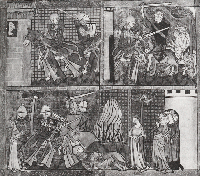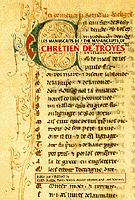

Explorations in Arthurian Legends
A Literature Review
Part 1: Chretien de Troyes
Previous discussions have focused on writers who have attempted to portray Arthur as historical in nature. We have seen that no matter how hard these writers try, they cannot help but invent conventions because they have so little to go on. Still, their Arthur was a figure of history whose deeds could be rooted in things that actually happened and places that could conceivably be identified.
Geoffrey of Monmouth started the fiction ball rolling with his History of the Kings of Briton, which introduced many fanciful notions, including the idea that Britain had never been conquered by the Romans. Wace introduced the idea of courtly love. It was up to his fellow Frenchmen to elaborate on this theme.
We start with the towering giant, Chretien de Troyes. We have seen that earlier tales of Arthur drew on Welsh tales and the events of the times of the writers to portray Arthur differently. Geoffrey of Monmouth has given us the begetting and birth of Arthur at Tintagel and Arthur's marriage to Guinevere (though he calls her Ganhumara). Wace has given us the Round Table and Excalibur. What, then, of the three remaining giant concepts in Arthurian lore: Camelot, Lancelot, and the Holy Grail?

|
They are the product of one man: Chretien de Troyes. He was born about the time Geoffrey was publishing his History of the Kings of Britain and was closely associated with the Countess Marie, daughter of Eleanor of Aquitaine, who later became queen to England's Henry II. From this association and a possible visit to England, Chretien fosters a keen intererest in court life and love.
He begins his literary career with a translation of Ovid's Art of Love and a version of the Tristan legend. He then moves full swing into matters Arthurian with Erec, a prose tale about a knight of Arthur's court who overcomes a fair number of trials and his own suspicions to claim the love of his betrothed, Enide. He also earns the right to inherit the kingdom of his father, Lac. In this story, Arthur is holding court at Cardigan. Guinevere is mentioned, as are Kay and Gawain and a host of Arthurian knights. Even Lancelot is mentioned at one point. The court of Arthur is filled with magnificent things and people, led by the fabulous Arthur himself. The knights pursue games of chance and test of strength; when they're not doing that, they're wooing women. Chretien is well on his way. |
The next romance to consider is Cliges, which also uses Arthur's court as a backdrop. The main character, Cliges, is the son of Alexander Soredamurs. Cliges loves Fenice. Much of the action takes place in Constantinople. In Cliges we see elements of witchcraft and Eastern themes. We also see two very different portraits of love: Cliges's parents have a great romance and then marry, happy. Cliges and Fenice have a great romance and then Fenice marries his uncle, the emperor of Constantinople. Fenice is significant in that she refuses to be involved in a love triangle, as did Isolde (Iseult). The magic potion Fenice uses gives her husband the impression of marital relations while in fact she remains intact. At the same time she refuses to have a bodily relationship with Cliges so long as she is his uncle's wife. A potion of the kind later to be used by Juliet at last delivers her and she is united with Cliges, having broken the triangle by her seeming death.
| Next up for Chretien was Yvain. We see the familiar love triangle theme emerge with Yvain when he develops a love for Laudine, the widow of the knight of the magic fountain (in the Broceliande Forest, no less). Yvain, of course, has killed this knight. Through the workings of Laudine's handmaid Lunette, the lady is brought to love the knight. But Yvain has other ideas: He wants to join Arthur's court. So, off he goes, promising to return in a year and a day. He somehow manages to forget to return, and she sends a message saying, in effect, "Don't bother coming home." The second part the romance is an account of Yvain's adventures and efforts to win back the heart of the woman he loves. The two most significant of these adventures are a battle with what turns out to be his dearest friend (whom he hearly kills) and the rescue of a lion, which follows Yvain everywhere he goes. Lunette proves instrumental in reuiniting the lovers. | 
|
 |
It is with The Knight of the Cart that we see Lancelot blossom into full form. He is the rescuer of Guinevere, here adbucted by Meleagant. He it is who waxes poetic and weak-kneed at the sight of Guinevere's golden hairs on a comb she left behind. He it is who plays the coward on her strict orders--and this at a tournament attended by all the important court members.
Lancelot's adventures include many marvels and wonders, including flaming lances and perilous beds. He even has to cross a bridge made of a single sharp sword to rescue Guinevere. And guiding him through all these trials, Chretien says, is his moral virtue, which comes from loyalty in love. |
| Lastly, we turn to Perceval, who stars in Chretien's Le Conte du Graal. As does the Lancelot work focus on the essence of courtly love, so does the Perceval work focus on the spiritual side of knightly quests. The overwhelming theme is the power of innocence. Chretien would seem to be saying that what you don't know can't hurt you.
Perceval knows nothing of chivalry even though his father and brothers died as knights-errant on quests; his mother has kept this knowledge from him and regrets it when he meets five knights by chance and determines to join them. Desperate, she gives her son a primer on behavior and approves his going away armed with simple means of defense. (The latter proves not too much of a difficulty, as Perceval manages to kill a relative and take his armor.) Perceval is made to appear as if he has a hard time grasping simple concepts. Indeed, he has trouble applying advice and knowing when to discard it. He falls in with Gornemant de Gohort, who warns him against talking too much or asking too many questions. These, Gornemant says, are the trappings of the ill-mannered. |

|
The young knight-hopeful does find love with Blancheflor, whom he rescues from her enemies, but finds that her embraces make him miss his mother. His disappointment is supreme when he finds that his mother has died of a broken heart. Did Perceval cause this? It's difficult to say. In any case, he didn't take her advice, and he didn't come back to her until it was too late.

|
The incident with the Fisher King is curious in that Perceval apparently did take Gornemant's advice and still came up short. Perceval encounters a mysterious fisherman who offers him shelter in his castle. When Perceval arrives at the castle, he finds the fisherman already there and lying on a couch in the great hall. A procession follows, led by a youth bearing a bleeding lance, two squires with golden candelabra, a beautiful woman carrying the golden graal, covered in precious stones, and another beautiful woman carrying a silver carving dish. Stunned by the beauty of what he is seeing and also mindful of Gornemant's warning not to ask unneeded questions, Perceval fails to ask the important question of what the ceremony means, an omission that will have disastrous consequences not only for him but for Britain as well.
Perceval commits him to finding his way back to the castle of the graal. Also entering the story at this point is Gawain, who is seeking the Bleeding Lance. Gawain seems to have become the main character. Perceval learns that the Fisher King is his cousin and that he is sustained by a single mass wafer served to him each day in the graal. Chretien's story ends here. Another author finished it later, but the differences in style and ability are evident. |
Chretien de Troyes gives us our first full glimpse of Lancelot and of the tradition that would become the Holy Grail. Perceval's tale is well rounded, and courtly love is now at the forefront of Arthurian stories.
It should be noted here that Chretien was quite clear in using the word graal, which is a flat serving dish. This is keeping with Celtic tales of vessels of plenty. So, too, with the lance.
Chretien did not describe a grail, a chalice. That description would be applied later, by Robert de Boron.
|
More on Chretien de Troyes
Translation of Yvain, or the Knight with the Lion |
Back to

Explorations in Arthurian History and Legends
Main
Page
Other